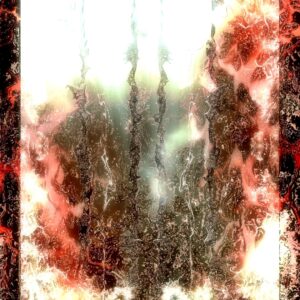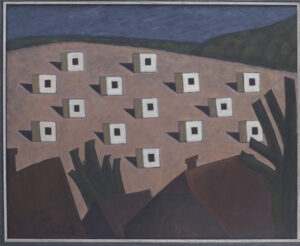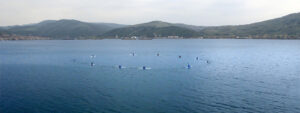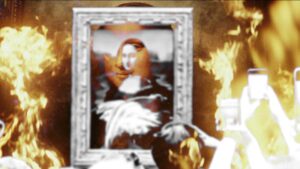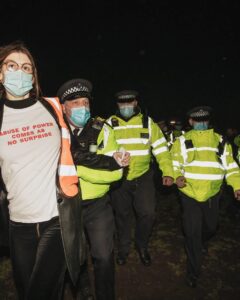My mission is to honour the ancestors, the stolen ones who were forced through the Door of No Return. (…) It is the responsibility of the living to honour the dead.
—Camille Turner, performance as Afronautic storyteller, Afronautic Research Lab: Newfoundland
In an attempt to contribute a combined definition of the terms return/repair, I turn to the evocative work of Black Canadian artist Camille Turner—particularly her 2019 video Afronautic Research Lab: Newfoundland (figure 1). The installation engages Turner’s ongoing research on the 19 slave ships that were built on the island’s eastern shore from 1751 to 1792,[1] and asks what return and repair mean in the wake of the transatlantic slave trade[2] from a Canadian context. The work centres on a filmed performance of Turner embodying a storyteller from the future who returns to present-day Newfoundland to recount this silenced history and memorialize those who were imprisoned and lost their lives on the ships. Using the Afronautic as her framework—which Turner defines as a nautical journey through space and time[3]—the artist’s performance posits thinking with the non-human and time-travelling as interconnected strategies for return/repair.
Figure 1. Afronautic Research Lab: Newfoundland (Camille Turner, 2019, with Brian Ricks as cinematographer/editor).
The rocks who witnessed these crimes are stranded on the other side of the Atlantic. Rocks do not forget. They will always be a part of this place.
The Afronaut holds a stone throughout her journey, which we learn links the western and eastern geographies on either side of the Atlantic. She explains that when the slave ships were built, stones from Newfoundland’s shore were used as ballast; when the ships arrived to the African continent, the stones were dumped overboard and replaced with the bodies of enslaved persons. In engaging the ballast stone as a witness to these horrors, the time-traveller activates the non-human as an alternative record to the colonial archive’s silences[4] and its dehumanizing logic—what Kathryn Yusoff terms “White Geology”[5]—that prescribed Black bodies and the non-human as fungible. The displaced stone returns to mark the site of violence and haunt the silence that marks claims to innocence in our settler colonial present. Turner’s repositioning of the stone as a narrative ally gestures to what Yusoff writes of as “an insurgent geology for the end of the world, for the possibility of other worlds not marked by anti-Blackness, where the inhuman is a relation, no longer an appendage of fungibility.”[6]
I tell stories of the Reckoning, the time when crimes of the past were laid bare, transgressions atoned for; debts owed were paid. The time of the Awakening followed. The world was unmade and recreated anew.
The Afronaut’s foresight into the future reveals that return leads to reckoning, and sustained reckoning leads to repair. In recovering the memory of the ships, Turner sets the groundwork for reckoning, awakening us to the importance of listening to the earth’s archive: an archive for the future.
Notes
[1] Turner’s research on Newfoundland’s role in the transatlantic slave trade developed from her participation in the 2016 exhibition “New-Found-Lands: Exploring Historical and Contemporary Connections between Newfoundland and the Caribbean Diaspora,” co-curated by Pamela Edmonds and Bushra Junaid at Eastern Edge Gallery. Turner’s research was also recently published in her PhD thesis “Unsilencing the Past: Staging Black Atlantic Memory in Canada and Beyond” (York University, 2022). Moreover, Junaid’s pivotal research on Newfoundland’s connection to the Black Atlantic has also taken many forms, and was recently published in her chapter “Of Salt Fish and Molasses: Making Visible the Caribbean Presence in this Province’s Past” in Future Possible: An Art History of Newfoundland and Labrador (2021, ed. Mireille Eagan), pp.103-113.
[2] After Christina Sharpe. In her book In The Wake: On Blackness and Being (2016), Sharpe formulates the multiple meanings of the wake as an analytic to map the afterlives of slavery. Turner’s work engages this notion of the wake and how Sharpe describes its relationship to time: “In the wake, the past that is not past reappears, always, to rupture the present” (9).
[3] Turner, personal communication with the author, May 18, 2021.
[4] Echoing Turner’s search for alternatives to the colonial archive’s erasures, Sharpe notes that Black scholars of slavery “must become undisciplined. The work we do requires new modes and methods of research and teaching; news ways of entering and leaving the archives of slavery” (13).
[5] In A Billion Black Anthropocenes or None (Minneapolis: University of Minnesota Press, 2018), Yusoff outlines the interconnection of geology and the whiteness of humanism by stating that, “To trace racial matterings across the category of the inhuman, and specifically the traffic between the inhuman as matter and the inhuman as race, is to examine how the concept of the inhuman is a connective hinge in the twinned discourses of geology and humanism” (5).
[6] Yusoff, A Billion Black Anthropocenes or None, 107-108.
About the author
Valérie Frappier is a white French-Canadian settler writer and arts worker who grew up in Dish With One Spoon territory between Lake Simcoe and Lake Ontario. Her research focuses on how artists utilize performance/creative practice to engage with memory, historical narratives and the non-human. She holds an MFA in Criticism and Curatorial Practice from OCAD University, as well as degrees from York and Concordia Universities.
